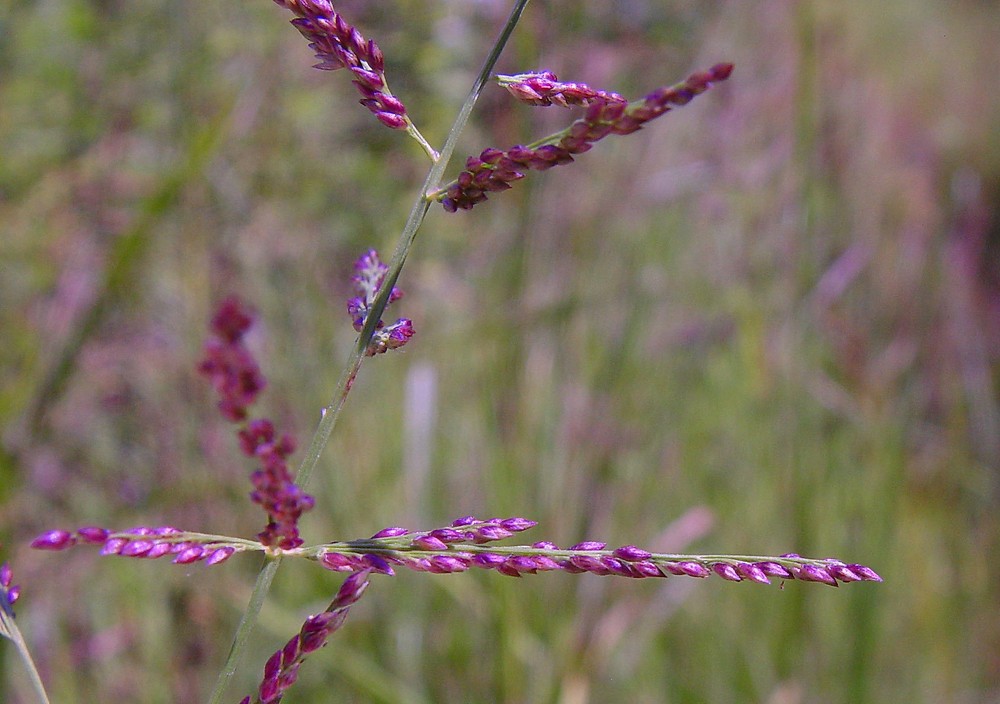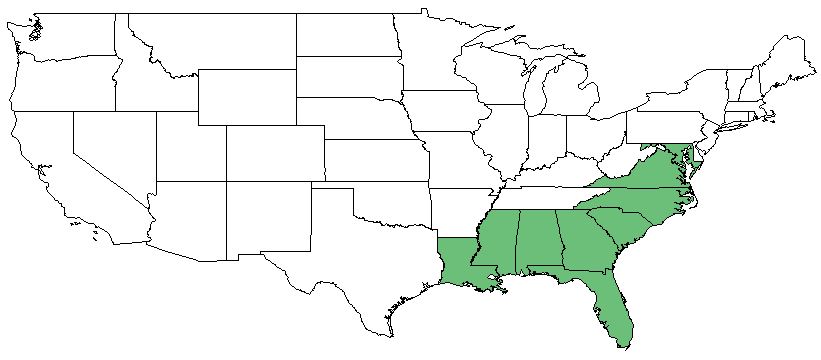Difference between revisions of "Coleataenia longifolia"
(→Distribution) |
HaleighJoM (talk | contribs) (→Ecology) |
||
| (4 intermediate revisions by 2 users not shown) | |||
| Line 31: | Line 31: | ||
==Distribution== | ==Distribution== | ||
| − | ''C. longifolia'' is commonly found in the south and eastern United States. <ref name= "USDA"> [https://plants.usda.gov/core/profile?symbol=CEAM USDA Plant Database]</ref> The subspecies, ssp. ''cobsii'' can be found along the outer Coastal Plain from southeast Massachusetts to Florida and west to southeast Louisiana, while ssp. ''longifolia'' can be found in the rest of the native distribution.<ref name= "Weakley"/> | + | ''C. longifolia'' is commonly found in the south and eastern United States.<ref name= "USDA"> [https://plants.usda.gov/core/profile?symbol=CEAM USDA Plant Database]</ref> The subspecies, ssp. ''cobsii'' can be found along the outer Coastal Plain from southeast Massachusetts to Florida and west to southeast Louisiana, while ssp. ''longifolia'' can be found in the rest of the native distribution.<ref name= "Weakley"/> |
==Ecology== | ==Ecology== | ||
===Habitat=== <!--Natural communities, human disturbed habitats, topography, hydrology, soils, light, fire regime requirements for removal of competition, etc.--> | ===Habitat=== <!--Natural communities, human disturbed habitats, topography, hydrology, soils, light, fire regime requirements for removal of competition, etc.--> | ||
| − | + | ''Coleataenia longifolia'' is listed as a facultative upland species that usually occurs in non-wetland areas, but can also be found in wetland habitats<ref name= "USDA"/> such as pond shores, depression meadows, cypress savannas, marshes, and low woods.<ref name= "Weakley"/> This species has been recovered for specimens from habitats including bogs, bottomland of hardwood forests, moist loamy sands, of pinelands, and wet shady loam near streams.<ref name = "FSU herbarium"> URL: http://herbarium.bio.fsu.edu. Last accessed: June 2018. Collectors: John B. Nelson, M.Darst, H. Light, Loran C. Anderson. States and counties: Florida (Dixie, Hamilton, Leon) South Carolina (Richland)</ref> | |
| − | Associated species | + | ''C. longifolia'' ssp. ''combsii'' is a longleaf pine ecosystem associate that is considered rare in Georgia.<ref name= "Walker">Walker, J. (1993). Rare vascular plant taxa associated with the longleaf pine ecosystems: Patterns in taxonomy and ecology. Tall Timbers Fire Ecology Conference, Tall Timbers Research Station, Tallahassee, FL.</ref> |
| + | |||
| + | Associated species include ''Triadica sebifera'', ''[[Rhexia virginica]]'', ''[[Rhexia mariana]]'', ''Cinna arundinacea'', ''Scirpus cyperinus'', ''Eupatorium serotinum'', ''[[Quercus virginiana]]'', ''[[Quercus laurifolia]]'', ''[[Liquidambar styraciflua]]'', ''Carya'' sp., and ''Fagus'' sp.<ref name= "FSU herbarium"/> | ||
===Phenology=== <!--Timing off flowering, fruiting, seed dispersal, and environmental triggers. Cite PanFlora website if appropriate: http://www.gilnelson.com/PanFlora/ --> | ===Phenology=== <!--Timing off flowering, fruiting, seed dispersal, and environmental triggers. Cite PanFlora website if appropriate: http://www.gilnelson.com/PanFlora/ --> | ||
| Line 44: | Line 46: | ||
<!--===Seed bank and germination===--> | <!--===Seed bank and germination===--> | ||
<!--===Fire ecology===--> <!--Fire tolerance, fire dependence, adaptive fire responses--> | <!--===Fire ecology===--> <!--Fire tolerance, fire dependence, adaptive fire responses--> | ||
| − | <!--===Pollination and | + | <!--===Pollination===--> |
| − | <!--==Diseases and parasites==--> | + | <!--===Herbivory and toxicology===--> |
| + | <!--===Diseases and parasites===--> | ||
==Conservation, cultivation, and restoration== | ==Conservation, cultivation, and restoration== | ||
Latest revision as of 12:51, 22 June 2022
Common Names: Lelong Redtop Panicgrass [1]
| Coleataenia longifolia | |
|---|---|

| |
| Photo by © Arthur Haines, New England Wild Flower Society | |
| Scientific classification | |
| Kingdom: | Plantae |
| Division: | Magnoliophyta - Flowering plants |
| Class: | Liliopsida - Moncots |
| Order: | Cyperales |
| Family: | Poaceae |
| Genus: | Coleataenia |
| Species: | C. longifolia |
| Binomial name | |
| Coleataenia longifolia Torr. | |

| |
| Natural range of Coleataenia longifolia from Weakley [2] | |
Contents
[hide]Taxonomic Notes
Synonyms: Sorengia longifolia (Torrey) Zuloaga & Morrone ssp. combsii (Scribner & C.R. Ball) Zuloaga & Morrone; Panicum longifolium Torrey var. combsii (Scribner & C.R. Ball) Fernald; Panicum rigidulum Bosc ex Nees ssp. combsii (Scribner & C.R. Ball) Freckmann & Lelong; Panicum rigidulum Bosc ex Nees var. combsii (Scribner & C.R. Ball) Lelong; Panicum longifolium; Panicum combsii Scribner & C.R. Ball.[3]
Varieties: none.[3]
Subspecies: Coleataenia longifolia (Torrey) Soreng ssp. combsii (Scribner & C.R. Ball) Soreng; Coleataenia longifolia (Torrey) Soreng ssp. longifolia.[3]
Description
C. longifolia is a perennial graminoid of the Poaceae family native to North America. [1]
Distribution
C. longifolia is commonly found in the south and eastern United States.[1] The subspecies, ssp. cobsii can be found along the outer Coastal Plain from southeast Massachusetts to Florida and west to southeast Louisiana, while ssp. longifolia can be found in the rest of the native distribution.[2]
Ecology
Habitat
Coleataenia longifolia is listed as a facultative upland species that usually occurs in non-wetland areas, but can also be found in wetland habitats[1] such as pond shores, depression meadows, cypress savannas, marshes, and low woods.[2] This species has been recovered for specimens from habitats including bogs, bottomland of hardwood forests, moist loamy sands, of pinelands, and wet shady loam near streams.[4]
C. longifolia ssp. combsii is a longleaf pine ecosystem associate that is considered rare in Georgia.[5]
Associated species include Triadica sebifera, Rhexia virginica, Rhexia mariana, Cinna arundinacea, Scirpus cyperinus, Eupatorium serotinum, Quercus virginiana, Quercus laurifolia, Liquidambar styraciflua, Carya sp., and Fagus sp.[4]
Phenology
C. longifolia has been observed to flower in December.[6] However, C. longifolia ssp. comsii is noted to flower in the summer.[5]
Conservation, cultivation, and restoration
C. longifolia is listed as threatened by the Michigan Department of Natural Resources and the Massachusetts Division of Fisheries and Wildlife. It is also listed as extirpated by the Indiana Department of Natural Resources, as presumed extirpated by the Ohio Department of Natural Resources, and a species of special concern by the Rhode Island Department of Environmental Management.[1]
Cultural use
Photo Gallery
References and notes
- ↑ Jump up to: 1.0 1.1 1.2 1.3 1.4 USDA Plant Database
- ↑ Jump up to: 2.0 2.1 2.2 Weakley, Alan S. 2015. Flora of the Southern and Mid-Atlantic States: Working Draft of 21 May 2015. University of North Carolina, Chapel Hill, North Carolina. 1320 pp.
- ↑ Jump up to: 3.0 3.1 3.2 Weakley, A.S. 2015. Flora of the southern and mid-atlantic states. Working Draft of 21 May 2015. University of North Carolina at Chapel Hill, Chapel Hill, North Carolina.
- ↑ Jump up to: 4.0 4.1 URL: http://herbarium.bio.fsu.edu. Last accessed: June 2018. Collectors: John B. Nelson, M.Darst, H. Light, Loran C. Anderson. States and counties: Florida (Dixie, Hamilton, Leon) South Carolina (Richland)
- ↑ Jump up to: 5.0 5.1 Walker, J. (1993). Rare vascular plant taxa associated with the longleaf pine ecosystems: Patterns in taxonomy and ecology. Tall Timbers Fire Ecology Conference, Tall Timbers Research Station, Tallahassee, FL.
- Jump up ↑ Nelson, G. PanFlora: Plant data for the eastern United States with emphasis on the Southeastern Coastal Plains, Florida, and the Florida Panhandle. www.gilnelson.com/PanFlora/ Accessed: 8 APR 2019